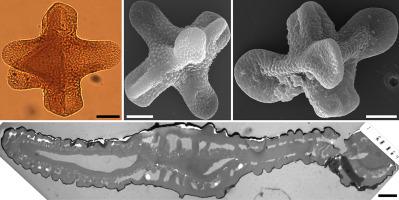当前位置:
X-MOL 学术
›
Rev. Palaeobot. Palynol.
›
论文详情
Our official English website, www.x-mol.net, welcomes your feedback! (Note: you will need to create a separate account there.)
Three Aquilapollenites species from the late Maastrichtian of China: New data and comparisons
Review of Palaeobotany and Palynology ( IF 1.9 ) Pub Date : 2020-11-01 , DOI: 10.1016/j.revpalbo.2020.104288 Maria Tekleva , Svetlana Polevova , Eugenia Bugdaeva , Valentina Markevich , Ge Sun
Review of Palaeobotany and Palynology ( IF 1.9 ) Pub Date : 2020-11-01 , DOI: 10.1016/j.revpalbo.2020.104288 Maria Tekleva , Svetlana Polevova , Eugenia Bugdaeva , Valentina Markevich , Ge Sun

|
Abstract Three species, Aquilapollenites quadricretaceus, A. stelckii, and A. amicus, from the late Maastrichtian of China have been studied using light, scanning, and transmission electron microscopy. Rare specimens of Aquilapollenites quadricretaceus and A. stelckii with reduced polar and/or equatorial projections were observed. A. quadricretaceus and A. stelckii are more similar to each other in exine ultrastructure than they are to A. amicus, which has a thicker foot layer and thin infratectum. A comparison with extant Lythraceae pollen revealed characters similar to those of triprojectate pollen, probably resulting from convergent evolution: prolate pollen with protruding equatorial ora and pores, frequent occurrence of striate and reticulate exine sculpturing, consistent presence of endexine, and infratectal columellae that are mostly simple and not branched. The colporate condition is rare in Triprojectacites and occurs in species with rather short equatorial projections, which suggests that the protruding part of the pollen grain, corresponding to the equatorial projections seen in Triprojectacites, might have been replaced functionally by the ora in tricolporate pollen like that of extant angiosperms. The possible adaptation of some Triprojectacites species to a wetland environment is suggested based on comparison with extant pollen.
更新日期:2020-11-01



























 京公网安备 11010802027423号
京公网安备 11010802027423号